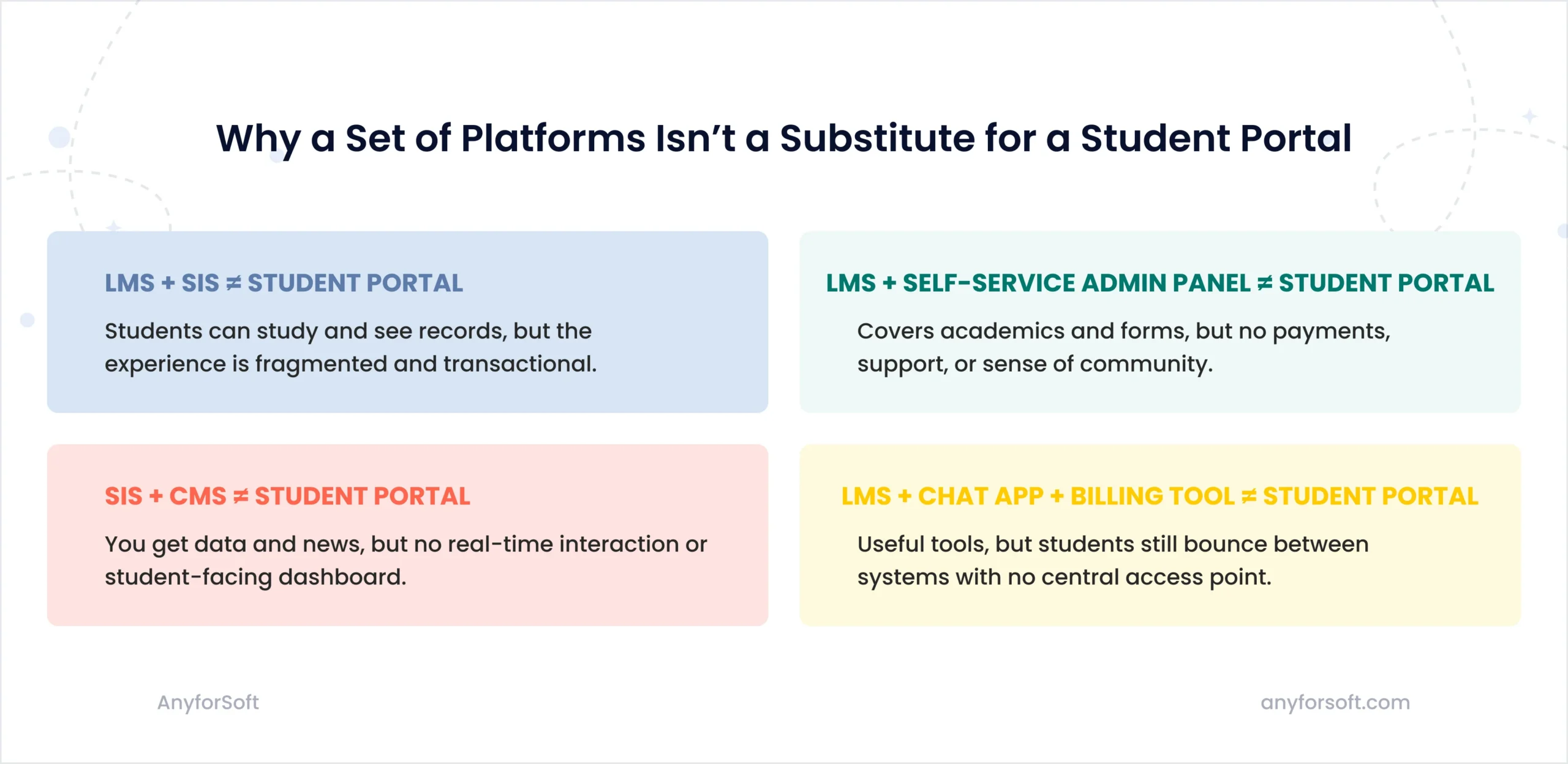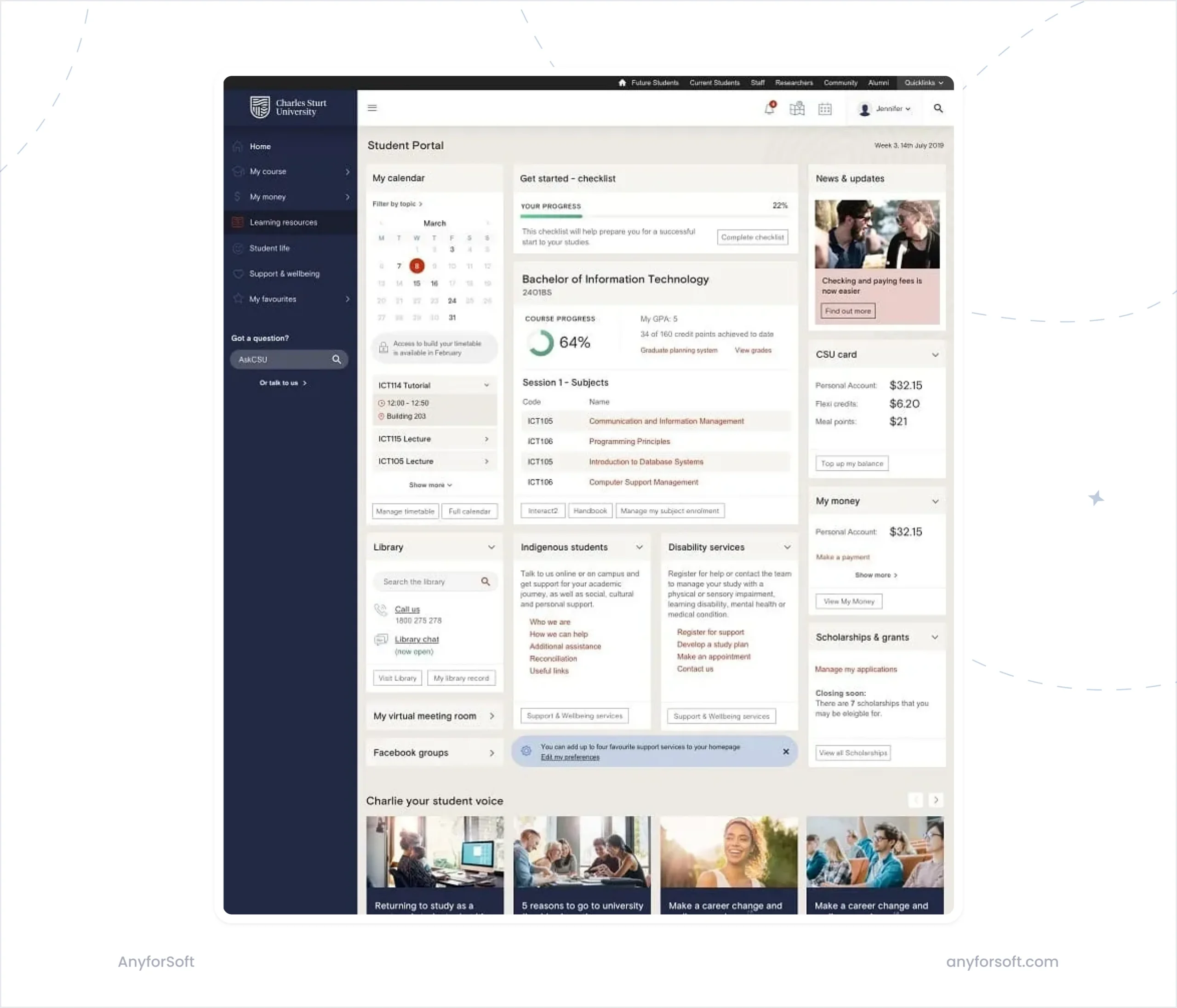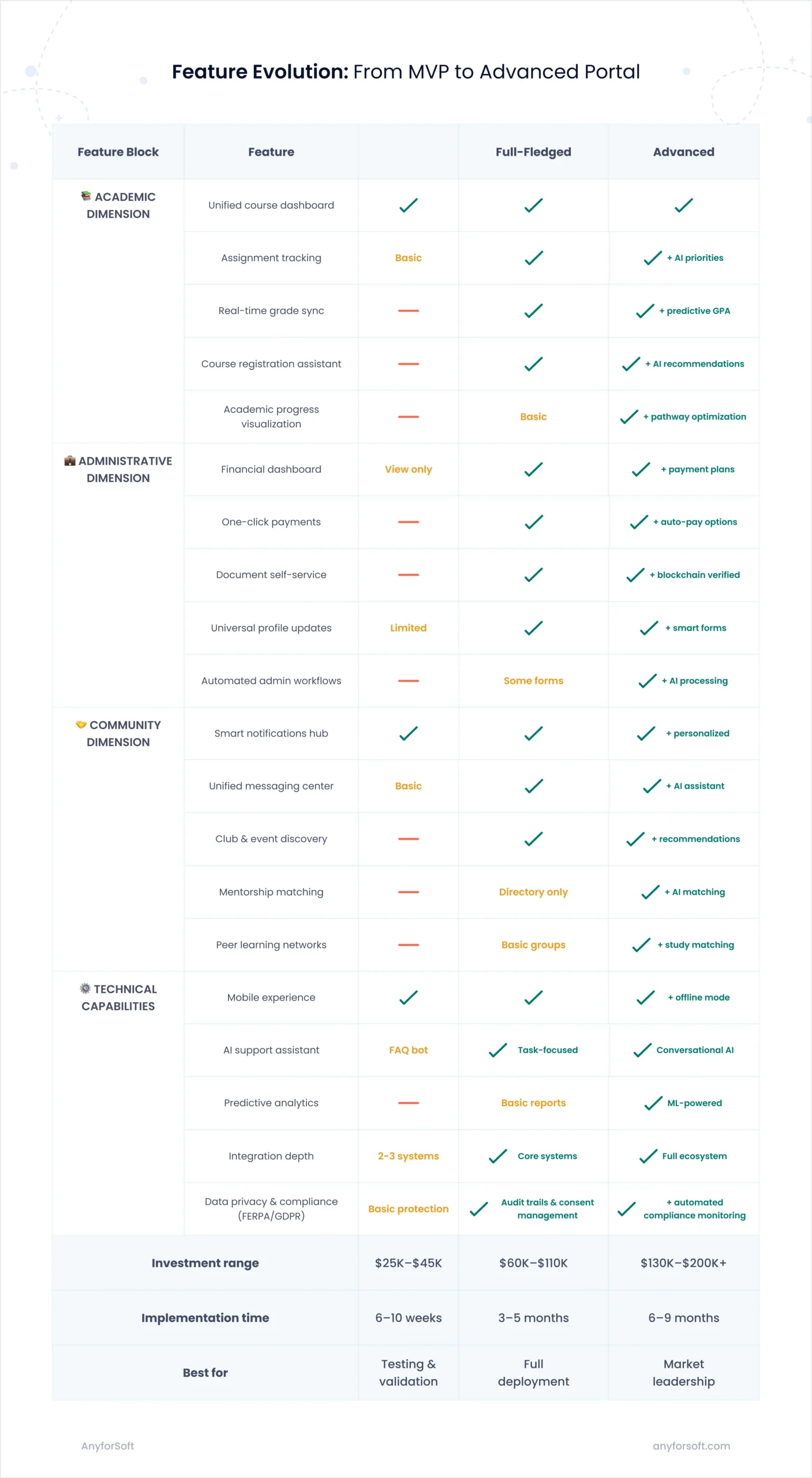When you’ve already invested in an LMS, SIS, website, and a dozen other tools, creating a student portal might sound like overkill.
Another system to maintain. Another login to remember. Another layer of tech.
Instead, a portal might serve as a bridge, one that collapses the distance between all the moving parts of the student experience.
Without one, students navigate a maze of logins:
- Grades in SIS.
- Coursework in the LMS.
- Announcements on a separate page.
- Payments, advising, and communication split across apps and inboxes.
Each system operates in its own isolated universe forcing students to memorize interfaces, context-switch constantly, and make sense of experiences that were never designed to work together.
A student portal brings it all into one place.
At AnyforSoft, we’ve spent 14+ years working with universities and learning platforms — many of which started with the same fragmented setup. LMS over here. SIS over there. Google Sheets holding it all together.
If all that sounds too familiar, you’ve landed on the right page. In this article, you’ll learn exactly what a student portal is, why it is more than a tech decision, and how to create a student portal yourself.
What Makes a Portal… a Portal?
A student portal is a secure digital platform that serves as a centralized hub for students that manages and automates academic, administrative, and community-related processes within an educational institution.
You might recognize some of these features from tools your institution already uses, including:
- LMS (Learning Management System)—provides access to study materials, assignments, grades, and library resources.
- SIS (Student Information System)—stores and shows student data like enrollment, grades, and tuition.
- SRM (Student Relationship Management System)—helps track and manage communication with students.
- Campus services / CMS—provides school news, updates, and internal resources.
- Mobile campus app—shows schedules, reminders, and campus info on mobile devices.
Each of these systems plays an important role, but on their own, they often create a fragmented experience. A student portal integrates these systems and expands on their capabilities, delivering a single, seamless experience for learners.

Obviously, a self-sufficient platform is better than the sum of different platforms’ capabilities.
“We already have some of the listed tools. We’ve spent money and effort on them. Should we start from scratch when building a student portal to provide our students with a smooth learning experience?”The answer is no. In most cases, whether you’re debating LMS vs SIS or already using a mix of these tools, you can still turn your existing tools into a single, student-friendly experience.

The Institution’s Side: Strategic Benefits of Student Portals
Portal benefits don’t stop with students. Institutions gain real operational advantages from bridging student organizational tasks and opportunities to handle them on a single platform.
- Reduced support load. A self-service portal means fewer tickets, emails, and walk-ins through streamlining administrative processes. Students find what they need when they need it.
- Data-driven decision-making. With usage analytics, admin dashboards, and student behavior tracking, your institution can act on real insights rather than assumptions.
- Consistent brand experience. From admissions to alumni services, a unified interface strengthens your institution’s identity and builds trust.
- Higher ROI on existing systems. A portal integrates your SIS, LMS, and other platforms, maximizing their value without replacing them.
Together, these benefits translate into measurable cost savings and smoother daily operations.
What a Student Portal Really Does: One day, Three scenarios
In a nutshell, portals quietly remove friction from a student’s day across finance, academics, and campus life. And while your institution may have its own systems and workflows, your students might still experience them as a disconnected blur of links, Moodle vs Canvas logins, and browser tabs.
Here are a few real-world examples of student portals in action.
Let us introduce Sarah. Follow her through a typical Tuesday at university.
8:00 AM—Administrative dimension
Payment panic: Sarah gets an email: “Tuition overdue.” She needs to check her balance and academic records, but can’t remember if her scholarship was applied. The finance office doesn’t open until 9 AM, and she has class then.How the Charles Sturt portal solves it: Sarah logs in and immediately sees her financial dashboard with a clear balance breakdown. She pays online with her saved payment method and downloads the receipt. Crisis solved before breakfast.

12:30 PM—Academic dimension
Registration nightmare: Sarah needs one more elective to graduate. She’s been refreshing the registration page all morning but can’t tell which courses have open seats or fit her schedule.How Stanton portal solves it: Sarah sees all available courses at once, course registration is seamless with open seats clearly marked; her current schedule prevents conflicts, and she can enroll directly. She picks “Introduction to Sales and Marketing” and confirms in seconds.

4:00 PM—Community dimension
Missing connections: Sarah’s advisor mentioned a graduate info session this week, but she can’t find details anywhere. Last month she missed a crucial deadline workshop because it was only posted on a bulletin board she never saw.How the Liaison University portal solves it: Sarah’s dashboard shows “Upcoming Events” prominently. Sarah clicks “View All” and discovers three other relevant events she didn’t know about. One click to register.

Important: You don’t need to tear down your existing systems to create something better. A portal can integrate, extend, and enhance the experience you currently deliver.
For example, one of AnyforSoft university clients wanted to create a virtual campus tour. The goal was to build an immersive, cross-platform experience that reflected student life and helped prospective students feel connected from day one.
Together, we layered an interactive campus map on top of their existing site infrastructure, built tools for internal teams to manage content easily, and delivered something that didn’t just look good. And it worked.
One Portal, Different Purposes: Academic Institutions vs. Business Schools
No two portals should look or function the same.
For business schools, the portal is often a launchpad connecting students to networking events, career coaching, and global cohort experiences. What matters most is flexibility, employer-facing features, and real-time updates that support ambitious professionals on the move.
For public academic institutions, the portal leans more toward stability and depth. It provides clarity around coursework, grades, academic calendars, and faculty support.
We’ve worked with both — from traditional universities to top-tier business schools like Imperial College — so let’s compare how student portals play out in different setups.
Comparison: Student Portal by Institution Type
| Academic Institution | Private Business School | |
|---|---|---|
| Main objective | Support students in academic achievement and knowledge building | Support career growth and real-world business exposure |
| Portal focus | Learning progress, grades, academic resources | Networking, mentorship, professional opportunities |
| Key academic tools | Course schedules, grade reports, exam access | Executive course materials, personalized learning paths |
| Administrative tools | Tuition payments, transcript access, academic forms | Tuition and event registration, travel booking for off-site programs |
| Communication tools | Messaging with professors and academic advisors | Direct messaging with mentors, career coaches, and alumni |
| Career features | Access to research opportunities and graduate program guidance | Job board, company profiles, mentorship programs, event calendars |
| Community focus | Forums, study groups, and campus clubs | Business clubs, pitch competitions, and networking meetups |
How to Create a Student Portal: A Starting Point
The best portals are the ones that align with your mission and meet students where they are.
At AnyforSoft, we’ve worked with both academic institutions and business schools to design platforms that reflect their core purpose.
For some, that means supporting researchers and creatives with structured academic tools.
For others, it means creating a dynamic hub for career development, networking, and global program delivery.
Regardless of the focus, the goal is the same: connect fragmented systems into a single, student-centered experience.
Here’s how to create a student portal in a few steps.
Step 1: Start with your students
After all, you create a portal for them. Map out key moments in their experience: enrollment, course access, communication, payments, support, career services. Identify where friction lives. This gives clarity on what your portal needs to surface and when.
Step 2: Audit your existing stack
You probably already have tools doing some of the work — SIS, LMS, email, CRM, etc.
Now the question is: what stays, what connects, and what’s missing? This step clarifies what the portal will orchestrate.
Step 3: Define your portal’s core layer (MVP)
Don’t start by planning every possible module. Instead, define the first version of your portal: the most essential 2–3 functions that will deliver real value.
That could be a unified dashboard. Or centralized course access. Or a communication hub.
Step 4: Build with modular architecture
Whether you’re working with a vendor or your in-house team, make sure your portal is modular by design. That’s why, at AnyforSoft, we like applying microservices architecture on our projects. For you, that means each layer — academic, financial, social — can evolve independently, which keeps maintenance light and future iterations flexible.
Step 5: Test with real users, then grow
Even an MVP needs testing. Launch to a small user group — maybe first-year students or a single department. Gather feedback on UX, clarity, and usefulness.
Once proven, you can layer on advanced features like personalized dashboards, AI assistants, or event integrations.
How Much Does a Student Portal Cost: MVP, Full-Fledged, or Future-Ready?
Educational institutions increasingly view AI in EdTech implementation as a strategic move. According to EDUCAUSE, as of late 2024, 57% of higher education institutions consider AI a strategic priority, up from 49% the previous year.
So it’s natural to ask yourself the question of whether it’s worth the investment and whether to layer AI on it. Let’s look into different phases of your project.
MVP: A smart first step
A minimum viable product (MVP) is your basic, working version of a student portal. It’s an optimal option if your goal is to test the waters, gather feedback, and launch a proof of concept before scaling up.
- User authentication
- Single dashboard for academic information
- Real-time financial balance visibility
- Direct messaging with support staff
- Basic mobile access
User roles: At this stage, the system typically supports students only, with a basic admin backend for updates. No role switching, no faculty dashboard, no layered permissions.
MVP is a simple way to unify key student tasks without replacing every other system you already have. An MVP can pull data from your LMS, SIS, or billing tools and show it in one place.
Some AI-powered capabilities, like a simple chatbot for answering FAQs or routing requests, can be implemented even at this stage, especially if your students rely heavily on digital self-service.
Even at the MVP stage, prioritizing features that enhance student engagement is crucial. A single tool can enhance user engagement significantly, as we saw in the case of virtual campus development. The outcome? Our client reported on Clutch “a noticeable uptick in student engagement.”
Estimated Cost: $25,000–$45,000
Timeline: 6–10 weeks
Full-fledged solution: The new normal
Once you know what your students need—and which gaps your MVP didn’t cover—it’s time to move toward a full-fledged student portal. This version connects all three core dimensions: academics, administration, and communication.
Here’s what it usually supports:
- Complete system integration (LMS, SIS, payment gateways)
- Self-service for administrative tasks
- Smart notifications across all channels
- Community hub with events and groups
- Document generation and management
Easy navigation through intuitive navigation menus ensures students find what they need quickly, while robust security measures protect sensitive data.
What makes this stage different is the cohesion among all features. Every service feels like part of the same experience, and your students stop asking which system they should log into.
At this stage, you may also want to create a virtual classroom—a real-time learning space that seamlessly integrates with other parts of the portal, enhancing student engagement.
User roles: This level introduces multiple portal users students, administrators, and faculty members with differentiated access. Faculty can view class rosters, advisors can support course planning, and admins have dashboards and reporting tools.
This is the most popular solution format for mid-sized and large institutions; it’s robust, adaptable, and future-friendly.
AI-powered tools, like personalized dashboards and course suggestions, document processing, or simple analytics dashboards, can enhance the experience and reduce staff workload without significantly increasing complexity.
Estimated Cost: $60,000–$110,000
Timeline: 3–5 months
Advanced solution: Smart, seamless, strategic
This is not just a portal anymore—it’s an intelligent hub tailored to your goals. Think personalized dashboards, real-time data syncing, and integrations with career services, alumni networks, or even third-party mentorship tools.
Advanced portals may include:
Core capabilities:
- AI-driven personalization and recommendations
- Predictive analytics for student success
- Extended ecosystem integration through cloud-based EdTech solutions (career, alumni, external tools)
- Intelligent automation of routine processes
- Advanced mobile experience with offline capabilities
User roles: Supports students, faculty, admins, mentors, alumni, and career coaches. Each role comes with personalized dashboards, dynamic access rules, and smart workflows.
This type of a platform doesn’t just serve students; it guides them. The portal supports your staff, too, by reducing repetitive tasks and revealing insights hidden in your data. It’s a digital companion that grows with your institution and reflects its DNA.
AI becomes central at this stage—enabling adaptive learning paths, early risk identification, and continuous service improvement across the board.
Estimated Cost: $130,000–$200,000+
Timeline: 6–9 months
Ready to see everything at a glance to find out how to create a student portal website? Here’s how our three portal types compare across all dimensions.

Conclusion
In a modern day and age, where institutions compete not just on rankings but on experience, student-centered design is no longer optional.
It’s the connective layer that ties your entire student journey together across tools, touchpoints, and goals.
Whether you’re modernizing your current digital ecosystem or planning school management software development from the ground up, the portal can serve as the central connector, bridging services, systems, and student needs.
The path to a successful student portal begins with evaluating costs, weighing benefits, and selecting the right solution. AnyforSoft is here to guide you at every stage.








